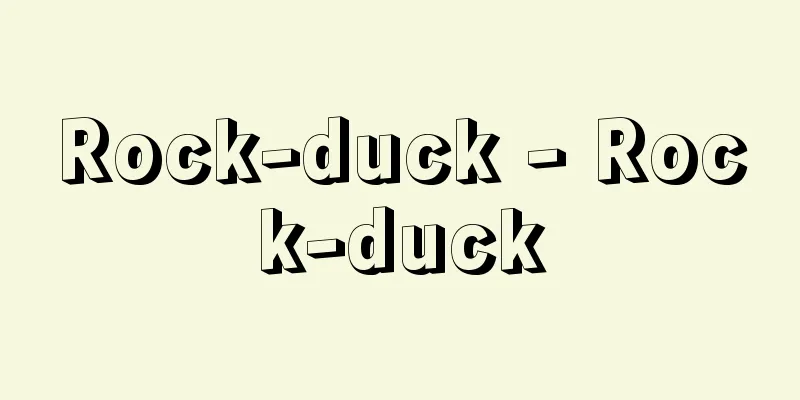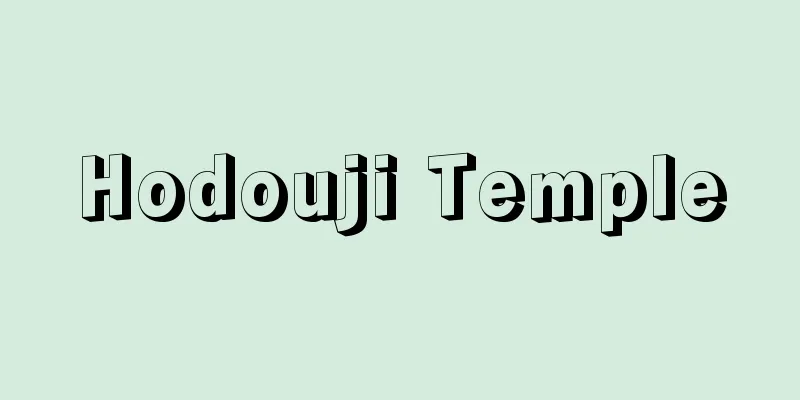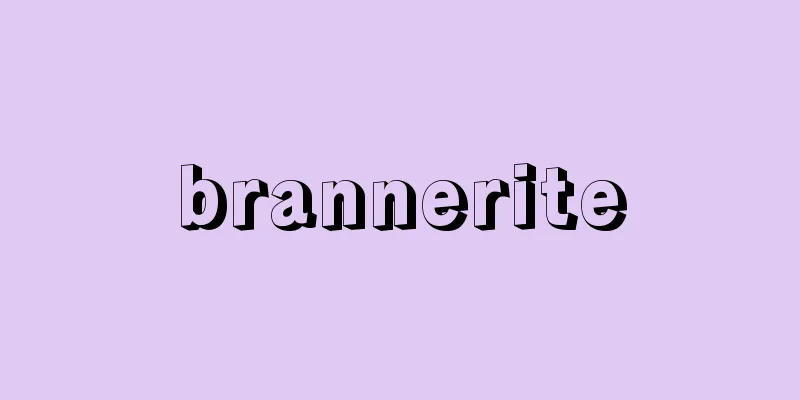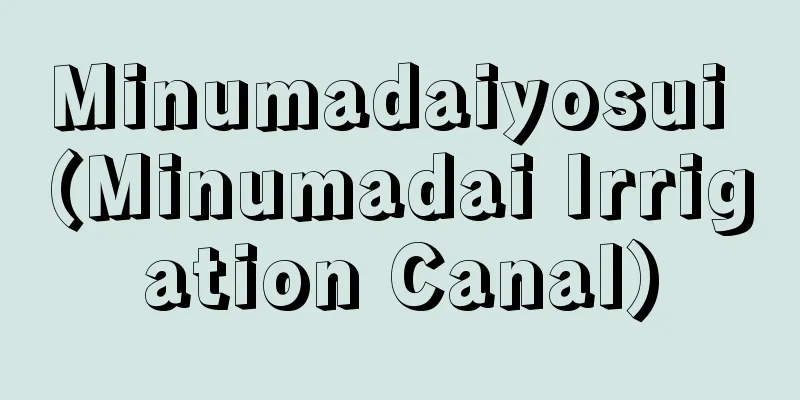Brush - Brush
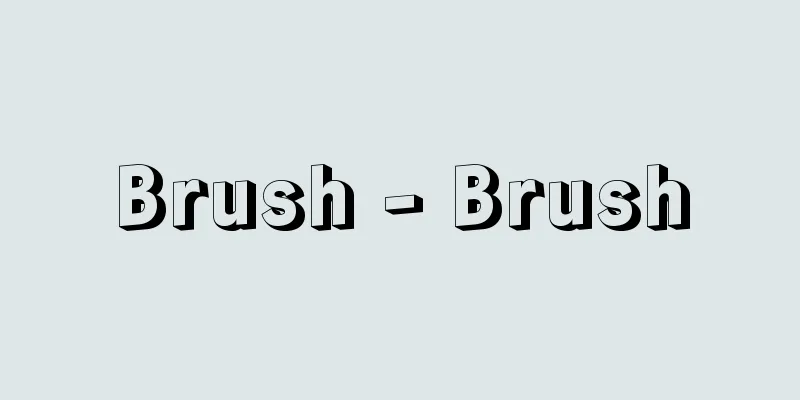
|
A brush is a tool used to write or draw, and generally uses animal hair for the tip. Writing implements such as pencils and fountain pens are also called brushes. It is also known as the "flower tree." [Uemura Kazudo] historyDocuments say that the origin of calligraphy brushes was General Meng Tian of the Qin Dynasty (221-206 BC), China, who was appointed as Guancheng (commander in chief) for his achievements, and so his brushes are said to have been nicknamed "Guancheng." In 1954, a brush was discovered in a brush case, along with a balance scale, bamboo strips, and a bronze knife, in a bamboo suitcase excavated from Tomb No. 15 in Zuojiagongshan, Changsha City, Hunan Province, China. This tomb belongs to the state of Chu, which was destroyed by the Qin Dynasty, and so this "Changsha brush" made of rabbit hair is said to be the oldest known brush. The "Juyan brush" is thought to be similar in shape to General Meng Tian's brush. This was excavated by the Northwest Scientific Exploration Team in 1930-1931 along with many other wooden tablets in the Juyan area (Inner Mongolia Autonomous Region) upstream of the Ejina River, and based on the wooden tablets, it is estimated to date to around 80-75 B.C.E. In 1932, a calligraphy brush was also excavated from the Han dynasty (2nd-3rd century B.C.E.) Lelang ruins, the Mokkaku Tomb No. 121 in Zhenbai-ri. The Changsha brush has a tube length of about 16.6 cm, a diameter of about 0.6 cm, and a tip length of about 2.5 cm, while the Juyan brush has a wooden shaft split into four, with the tip inserted at one end and tied with hemp thread, and the base hardened with lacquer. The tube length is about 21 cm, the diameter is about 0.7 cm, and the tip is about 1.4 cm, with a core of stiff bristles covered with a covering that appears to be wool. The Rakurō brush is close to the Ienobu brush in both era and production method. The history of the brush as seen from relics is as described above, but on white earthenware excavated together with tortoise shell and animal bone inscriptions from the Yin dynasty (16th to 13th centuries BC) there are patterns that appear to have only been made with a brush, and some of the oracle bone inscriptions appear to have been sketched in brush form before the characters were carved into them with a bronze knife.Furthermore, patterns on painted pottery from the even older Longshan and Yangshao periods at the end of the Neolithic period are also presumed to have been made with a brush, which suggests that the origins of the brush go back to before 2500 BC. Brushes were introduced to Japan from China and Korea, and are thought to have been in use already by the 5th century (the Nihon Shoki records that Wani of Baekje, who visited Japan at the end of the 4th century, presented ten volumes of the Analects and one volume of the Thousand Character Classic as tribute), but since the methods for making paper and ink were brought over by Goryeo monks in the early 7th century, it is believed that the method of making brushes was also introduced around the same time. [Uemura Kazudo] kindsThey can be categorized by size as "large brushes," "medium brushes," and "small brushes (thin brushes)." Among the large brushes, there are also extra-large brushes called "teito brushes." Based on the shape of the tip, they can be categorized as "long-tipped brushes," "short-tipped brushes," "menso brushes," "jakuto brushes" (short-tipped brushes shaped like a sparrow's head), "willow leaf brushes," "sabaki brushes," and "suihitsu brushes." Based on the material of the tip, they can be categorized as "hair brushes," "straw brushes," "grass brushes," "wood brushes," "hibiscus brushes," and so on. The animal hairs used for calligraphy brushes are usually those of rabbits, raccoon dogs, deer, sheep, and horses, but also those of cats, weasels, martens, mice, wolves, squirrels, foxes, monkeys, buffalo, bears, pigs, and deer, and sometimes even foals made from sheep's hair. Rabbit hair is also called shigou (purple hair) and has appeared in literature since ancient times. Also, 'kengou' refers to a mixture of two or more types of raw hair, and Shichi-Shi-San-Yang and Go-Shi-Go-Yang are examples of a mixture of rabbit hair and sheep hair, but this is rarely found in Japan today and is made exclusively in China. Winter animal hair is highly valued, but deer hair is also popular in summer. In one unusual legend, Wang Xizhi used a mouse-whisker brush made from rat whiskers to write the "Lanting Xu." [Uemura Kazudo] Manufacturing methodIn terms of manufacturing method, they can be broadly categorized into "mizufude" (water brush), where the tip is hardened with funori glue, "sabakifude" (brushes) which are left loose without being hardened, and the older "makifude" (wrapped brush), where the core is wrapped in paper and then top hair is applied. Using mizufude (water brushes) as an example, the manufacturing process is outlined as follows: first, the raw hair is straightened and degreased, after which the "kegoshirae" (hair preparation) is aligned on a hand board and "water hardened" to bring out the inochige (long hair that will become the core of the tip). A thin layer of hair is then wrapped around this and "nodozuke" (throated) to create the core. Hatage (field hair) is added to the top of the core and "shintate" (standing upright), then the top hair is applied and "ojime" (stitching) is done, and the shaft is "sugekomi" (sliding). The shaft is chamfered and recessed, the tip is attached with lacquer and glue, and then it is soaked in alum and squeezed.The name is then carved into the shaft, and the sheath is put in to finish it off. When putting down a new brush, the glue that has been applied to it must be washed off to keep it in shape. In addition, the quality of a brush can be judged based on four criteria: sharp (the tip is sharp and not irregular), even (the tip is neatly aligned when spread out), round (the tip has a smooth shape when soaked in water or ink), and healthy (the brush can draw solid lines without any breakdowns). Furthermore, when storing a brush, it is advisable to use an insect repellent to prevent insect damage to the tip. [Uemura Kazudo] Painting brushesThe history of paintbrushes dates back almost to the same time as the origin of painting, but their prototypes are thought to have been made from tree branches or grass stalks shaped like a bamboo fan , and in ancient Egypt, brushes made from loosened and bound reed fibers were used. It is believed that animal hair, as we know it today, has probably been used since prehistoric times. In China and Japan, most calligraphy and painting brushes are hair brushes, but in the West, hair brushes for painting and hard brushes (pens) for writing developed separately. [Hasegawa Saburo] Western Painting BrushesBroadly speaking, there are brushes with stiff bristles made from hog hair and soft bristles such as those made from marten or weasel hair, and today there are also brushes with stiff bristles made from nylon. The shape of the animal hair tip is used to make the brush tip, and in the past, the feather tube (shaft) of a bird's feather was used as a ferrule to hold the hair together, but nowadays, with the exception of small, high-end, specialized brushes such as those made from marten hair, most are made from metal. Sizes usually range from 0 (zero) to 12, but there are also very thin or wide brushes or brushes with long tips. [1] Pig bristle brushes These are the most common type of brush for oil painting, made from a part of the pig's back hair. Until the mid-19th century, round brushes were the only type used, but today there are four main types of brushes: (1) traditional round brushes, (2) flat brushes (2.5 times longer than their width), (3) bright type (a type of flat brush with a shorter tip and thinner, stiffer bristles than regular flat brushes), and (4) filbert type (a flattened version of a round brush). [2] Soft-hair brushes Brushes made from soft, flexible animal hair were used not only for watercolors and tempera paintings, but also for classical oil paintings. The highest quality, called Kolinsky, is made entirely from the hair of Siberian red sable, and is characterized by its excellent balance of strength and elasticity (resilience) and its delicate, sharp tips. This effect is achieved by the unique shape of the hair, which thickens in the middle and becomes sharp at the tip. Other animals that are used include the hair of white weasels, badgers, and squirrels (the hair known as "camel hair" comes from the tail hair of squirrels). Cow hair taken from cow ears is stiffer and more elastic than sable, and is mixed with sable to make watercolor brushes. [3] Nylon brushes are stiff nylon bristle brushes made for use with polymer resin paints such as acrylic paints. Since acrylic paints dry quickly, they must be soaked in water to prevent the brush from solidifying, so they must be made from a water-resistant material. [Hasegawa Saburo] Brushes for Japanese PaintingUntil the end of the Edo period, brushes were not particularly different from calligraphy brushes, but in the Meiji period, the influence of Western painting techniques and the revival movement of new Japanese painting led to the invention of various paint brushes. Materials used include goats, deer, rabbits, weasels, martens, and raccoon dogs, and by taking advantage of the properties of each animal's hair and combining them in various ways, brushes suited to different purposes are made, and they have names according to their uses. (1) Tsuketate brush: A convenient brush that can be used for both line drawing and mokkotsu. (2) Line drawing brush: The most Japanese brush, designed to allow for easy drawing of any thickness, thin, or curved line. (3) Menso brush: A brush used to draw particularly thin lines. (4) Coloring brush: In addition to being used for coloring, these brushes are useful for a wide range of purposes, and are often made from a mixture of deer hair and sheep's wool. The above are brushes with pointed tips. Other brushes with flat tips include (5) kumadori brushes, (6) hira brushes, (7) renpittsu brushes, and (8) hake brushes. [Hasegawa Saburo] "The Four Treasures of the Study: The Story of the Brush" by Sakaki Bokuzan (1981, Kadokawa Shoten)" ▽ "The Brush" by Kimura Yozan (1975, Daigakudo Shoten) ©Katsuya Nishikawa "> Names of the parts of a brush Source: Shogakukan Encyclopedia Nipponica About Encyclopedia Nipponica Information | Legend |
|
文字や絵をかく道具で、一般には穂に獣毛を用いる。筆記具としての筆は、鉛筆、万年筆などもあるため、とくに毛筆とよぶことも多い。また「花の木」の異称もある。 [植村和堂] 歴史毛筆の創始は文献上では中国の秦(しん)(前221~前206)の蒙恬(もうてん)将軍とされ、その功績により管城(かんじょう)に任ぜられたことから、筆には「管城」の異名が伝えられるほどであるが、1954年に中国湖南省長沙(ちょうさ)市左家公山の第15号墓から発掘された竹製の行李(こうり)のなかに、天秤(てんびん)、竹簡(ちくかん)、銅刀などとともに、筆筒に入れた筆が発見された。この墓は秦に滅ぼされた楚(そ)の国の墓であるところから、この兎毫(とごう)(兎(うさぎ)の毛)の「長沙(ちょうさ)筆」が現在判明している最古のものといわれる。蒙恬将軍の筆に近い形とみられるものに「居延(きょえん)筆」がある。これは1930~1931年に西北科学考査団がエチナ川上流の居延地区(内モンゴル自治区)で多くの木簡とともに発掘したもので、木簡から推定して紀元前80~前75年ごろと考えられる。また1932年には漢代(前2~後3世紀)の楽浪(らくろう)の遺跡、貞柏里(ていはくり)121号木槨(もっかく)古墳からも毛筆が出土している。長沙筆は管の長さ約16.6センチメートル、直径約0.6センチメートル、鋒(ほう)の長さ約2.5センチメートル、居延筆は木軸を四つ割りにした一端に穂を挿し込んで麻糸で縛り、根元を漆で固めてあり、管の長さ約21センチメートル、直径約0.7センチメートル、鋒の長さ約1.4センチメートルで、剛毛の芯(しん)の周囲に羊毛らしい上被がかけられている。「楽浪筆」は時代も製法も居延筆に近い。 遺品からみた筆の歴史は以上のとおりであるが、殷(いん)代(前16~前13世紀)の亀甲(きっこう)獣骨文とともに発掘された白色土器に、毛筆でなければ描けないと思われる文様があったり、甲骨文のなかには銅刀で文字を刻み込む前に毛筆で下書きしたと思われるものもある。またさらに古い新石器時代末期の竜山(りゅうざん)期や仰韶(ぎょうしょう)期の彩陶の文様も筆で描かれたと推定され、これによれば毛筆の起源は前2500年以前にまでさかのぼることになる。 日本の筆は中国、朝鮮から伝えられ、5世紀ごろにはすでに使われていたものと推察される(『日本書紀』に4世紀末来朝の百済(くだら)の王仁(わに)が『論語』10巻、『千字文』1巻を進貢したとみえる)が、7世紀初頭、高麗僧により紙墨の製法がもたらされていることから、製筆法もほぼ同じころ招来されたものと思われる。 [植村和堂] 種類大きさから分けると「大筆(おおふで)」「中筆(ちゅうふで)」「小筆(こふで)(細筆(ほそふで))」となる。大筆のなかには「提斗(ていと)筆」とよばれる超大筆もある。穂の形からは「長鋒(ちょうほう)筆」「短鋒筆」「面相(めんそう)筆」「雀頭(じゃくとう)筆」(雀(すずめ)の頭のような形の短鋒の筆)、「柳葉(やなぎば)筆」「捌(さば)き筆」「水筆(すいひつ)」などの別があり、また穂先の素材によって「毛筆」「藁筆(わらふで)」「草(くさ)筆」「木筆」「槿(むくげ)筆」などに分けられる。毛筆に使われる獣毛は兎、狸(たぬき)、鹿(しか)、羊、馬などが普通だが、猫、鼬(いたち)、貂(てん)、鼠(ねずみ)、狼(おおかみ)、栗鼠(りす)、狐(きつね)、猿、水牛、熊(くま)、豚、馴鹿(となかい)なども使われ、ときには胎髪筆もある。兎の毛は紫毫(しごう)ともよばれて、非常に古くから文献にみえる。また「兼毫(けんごう)」というのは2種以上の原毛を混ぜ合わせたもののことで、七紫三羊、五紫五羊などは兎の毛と羊の毛を混用した例であるが、現在の日本ではほとんど得られず、もっぱら中国でつくられる。獣毛は冬毛が珍重されるが、鹿毛だけは夏毛も喜ばれている。変わったところでは、王羲之(おうぎし)が『蘭亭序(らんていじょ)』を書くのに鼠のひげを集めた鼠鬚筆(そしゅひつ)を使ったという伝説がある。 [植村和堂] 製法製法上からは、穂先をふのりで固めた「水筆」、固めずにばらばらのままにした「捌き筆」、古い形態として心柱(しんちゅう)を紙で巻いた上に上毛(うわげ)をかけた「巻筆(まきふで)」に大別される。水筆を例に製法の概要を述べると、まず原毛の癖直し、脱脂のあと、「毛拵(けごしら)え」した毛を手板(ていた)でそろえ、「水固め」をして命毛(いのちげ)(穂の芯になる長い毛)を出す。その周りに薄く毛を巻き「のどづけ」をして心柱をつくる。心柱の上に畑毛(はたげ)を添えて「真立(しんた)て」をしたものに「上毛かけ」をして「苧締(おじ)め」をし、軸に「すげ込み」をする。軸の「面取り」「くり込み」をし、漆や接着剤などで穂をすげ、さらにふのり、みょうばんの液中に浸して絞る。そのうえで軸に銘を彫り、鞘(さや)をして仕上げとなる。 新しい筆を下ろすときは、形を整えるためにつけたふのりは洗い落とさなければならない。また筆の良否を見分けるのには、尖(せん)(穂先が鋭くて乱れのないこと)、斉(せい)(穂先を広げたときにきれいにそろっていること)、円(えん)(穂に水や墨を含ませたとき円満な姿であること)、健(けん)(充実した線が破綻(はたん)なく書けること)の4条件を参考にするとよい。さらに、保存するときは、穂の虫害を防ぐため防虫剤を用いることが望ましい。 [植村和堂] 絵画用の筆絵筆の歴史はほとんど絵画の起源と同時代にまでさかのぼるが、木の枝や草の茎をささら状にしたものが原型と考えられ、古代エジプトでは葦(あし)の繊維をほぐして束ねたものが使用されていた。今日のような獣毛も、おそらく先史時代から利用されていたものと推測される。中国や日本では書の筆も絵筆もほとんどが毛筆であるが、西洋では、絵画用の毛筆と筆記用の硬筆(ペン)とは、はっきり分かれて発達した。 [長谷川三郎] 西洋画の筆大別して豚毛の剛毛筆と貂(てん)、鼬(いたち)に代表される柔毛筆があり、今日ではナイロン製の剛毛筆もある。獣毛は毛先の形をそのまま生かして筆の穂先にし、古くは鳥の羽根の羽管(軸)が毛をまとめる口金がわりに使われたが、いまでは貂などの高級で小さな特殊なもの以外は、ほとんど金属製である。大きさは通常0(ゼロ)号から12号まであるが、ごく細いものや幅広のもの、あるいは穂先の長いものもある。 〔1〕豚毛の剛毛筆 豚の背毛の一部を用いてつくられた油彩用のもっとも標準的な筆。19世紀中葉まではほとんど丸筆だけであったが、今日では大別して次の4種の型の筆がつくられている。(1)伝統的な丸筆、(2)平筆(長さが幅の2.5倍)、(3)ブライト型(平筆の一種で、通常の平筆より穂先が短く、毛が薄くて剛(こわ)い)、(4)フィルバート型(丸筆を平たくした形)。 〔2〕柔毛の筆 柔らかくしなやかな獣毛製の筆は、水彩画やテンペラ画のみならず、古典的な油彩画にも用いられた。なかでもコリンスキーとよばれる最高級品は、シベリア産の赤貂(レッド・セーブル)の毛だけでできており、腰の強さと弾力(復原力)の兼ね合いに優れ、穂先が繊細で鋭いという特徴がある。これは、中間で太くなり、先端で鋭くとがっている独特の毛の形によって生ずる効果である。ほかに白鼬、穴熊(あなぐま)、栗鼠(りす)(「らくだ毛」とよばれているものは栗鼠の尾の毛)などの毛も使われている。また牛の耳からとる牛毛は、セーブルより剛くて弾力に富み、セーブルと混ぜて水彩筆用に使われる。 〔3〕ナイロン筆 アクリル絵の具などのポリマー樹脂絵の具のためにつくられたナイロン製の剛毛筆。アクリル絵の具は速乾性なので、水に浸して筆の凝固を防がなければならないため、水に強い材料でつくる必要がある。 [長谷川三郎] 日本画の筆江戸末期ごろまでは書の筆ととくに異ならなかったが、明治になって西洋絵画技法の影響と、新しい日本画の復興運動からさまざまな絵筆が考案された。材料には山羊、鹿、兎、鼬、貂、狸などが使われ、それぞれの毛の性質を生かし、各種組み合わせることで用にかなった筆がつくられ、用途別の名称がある。(1)付立(つけたて)筆 線描、没骨(もっこつ)のいずれにも使える便利な筆。(2)線描筆 細太、曲直のいずれも自在に引けるようくふうされたもっとも日本的な筆。(3)面相(めんそう)筆 特別に細い線を引くためのもの。(4)彩色筆 彩色用のほか幅広く役だち、鹿毛(かもう)と羊毛の混合が多い。以上は穂先のとがった筆で、ほかに先の平らなものとして、(5)隅取(くまどり)筆、(6)平(ひら)筆、(7)連筆(れんぴつ)、(8)刷毛(はけ)などがある。 [長谷川三郎] 『榊莫山著『文房四宝 筆の話』(1981・角川書店)』▽『木村陽山著『筆』(1975・大学堂書店)』 ©西川勝也"> 筆の各部名称 出典 小学館 日本大百科全書(ニッポニカ)日本大百科全書(ニッポニカ)について 情報 | 凡例 |
>>: Goods and articles - goods and articles
Recommend
Kondratii Fëdorovich Ryleev
Born: September 29, 1795, Batobo Died July 25, 182...
punto in aria (English spelling) puntoinaria
...The finished lace was very similar to needlepo...
Aizu Clan
A domain centered in the Mutsu region, Azuchi Cou...
Kumebe - Kumebe
In ancient times, they were a military tribe that ...
Hohberg, WHvon (English spelling) HohbergWHvon
...The duties of the father included the educatio...
Zǎo jǐng (English spelling)
A decorative ceiling used in ancient Chinese archi...
Bylany
... The older stage of the Danubian culture (Chil...
Katsurayama Koreshige
...The Omori clan of the Northern House of the Fu...
Ticket gate
〘 noun 〙① (━suru) To check passenger tickets, admi...
Cour d'Assises (English spelling)
…The jurisdiction and procedures of the courts ar...
County
A county is a unit of local government found in th...
Rounded vowels
A vowel pronounced by rounding the lips. In Englis...
Angelis - Angelis, Jeronimo de
Year of death: 13th October 1623 (4th December 162...
Kanamori Yorikane
1713-1763 A daimyo in the mid-Edo period. He was ...
ideologie (English spelling) ideologie
The name was coined by Destutt de Tracy. He pushe...


